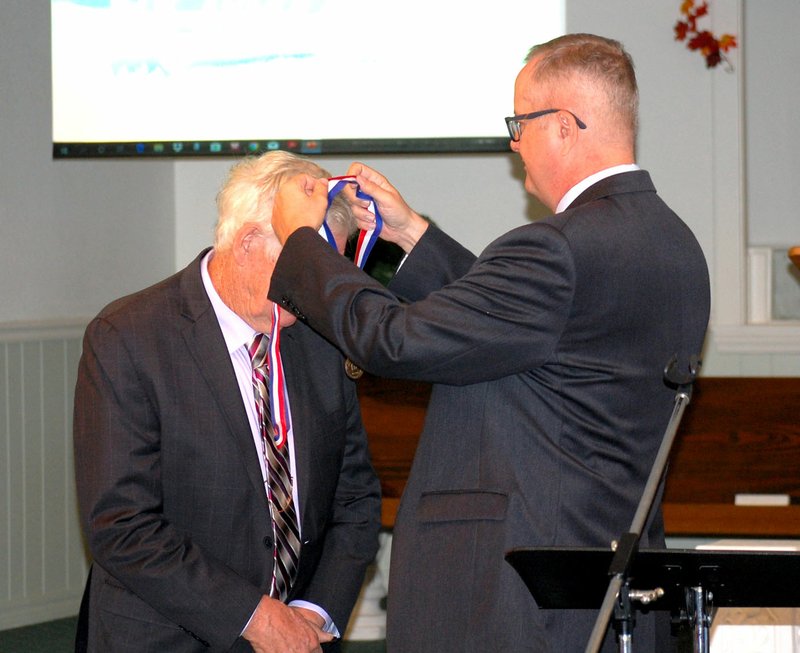Jerry Hart was not planning to receive a medal on Saturday, Nov. 2. He had planned simply to attend church with his wife Marion at the Siloam Springs Seventh-day Adventist Church on Waukesha Road.
When he arrived, he was surprised to find that he was scheduled to receive two medals for his service in a military project decades earlier.
"I was surprised," Hart said. "I had no idea that was going to happen that day."
Hart, a Siloam Springs resident, was part of a U.S. Army project known as Operation Whitecoat, which involved testing the effects of certain diseases on service members, according to Chaplain William Cork, assistant director of Adventist Chaplaincy Ministries.
As an Army medic, Hart learned about Operation Whitecoat while he was stationed at Fort Sam Houston, Texas, he said. After hearing about the project from representatives of the Army and the Seventh-day Adventist Church, Hart decided that it was something that he wanted to do, he said.
One of the reasons Hart joined Operation Whitecoat was because of his non-combatant status. He explained that he did not feel comfortable carrying a rifle.
"I wanted to save lives and not take lives," he said.
A soldier can apply for 1-A-0 conscientious objector status if they are sincerely opposed because of religious or deeply held moral or ethical beliefs to participating as a combatant in war, including training in tactics or using weapons, according to the U.S. Army website, army.mil. The soldier can then be assigned to noncombatant duties.
The Seventh-day Adventist church advocates for a noncombatant position, citing Christ's mission of coming into the world to save lives rather than destroy them, according to an April 2019 article on the world church's official website news.adventist.org. The article also states that the position is to give guidance to members, but leaves individuals free to assess the situation for themselves.
Hart began his service in Operation Whitecoat in August of 1962, he said. At first, he was a technician working with research animals, primarily monkeys, who were inoculated with staph, he said.
"We had to keep records of the phases they were in as they progressed because of the diseases," Hart said.
Eight months after he began his assignment, Hart was asked to participate in human trials for rabbit fever. The group he participated with was given medicine immediately after being inoculated with the disease, he said. Consequently, he did not experience any of the symptoms of rabbit fever and has suffered no lasting effects from the disease, he said.
When asked why he was willing to undergo the inoculation, Hart said he believed the Vietnam conflict was going to escalate and he wanted to do anything he could to help the government protect the troops.
"That was my intention," Hart said. "If I could help the troops."
After being discharged in November of 1964, Hart returned to his job on the railroad in the Oklahoma panhandle. In 1969, when his daughter reached school age, he decided to move back to the Siloam Springs area.
"We came back here to put her in church school over in Gentry," he said.
Hart said that he never attended any of the Whitecoat reunions because they were so far away and he didn't feel that he could afford it. When he received the medals from Cork, he was completely surprised and honored.
"I felt honored and I felt what I did was appreciated," Hart said. "If it helps somebody that's great."
Operation Whitecoat began in 1954 and ended in 1973 and was based in Fort Detrick, Md., according to Cork. Participants in the project were usually draftees who were registered as non-combatants, he said.
When the army began Operation Whitecoat, Lt. Col. William Tiggertt, an Army doctor, wrote to Dr. Theodore Flair, the secretary of the medical department of the General Conference of the Seventh-day Adventist Church, according to Cork.
Tiggertt wrote he had attended a conference and learned that Seventh-day Adventists have a strong commitment to health and that many served as Army medics, Cork said. Tiggertt proposed promoting Operation Whitecoat exclusively to the Adventist medics finishing up their advanced individual training.
According to Cork, the church took three weeks to make a decision and agreed to the proposal. The chaplin added that from that time on, a representative of the Seventh-day Adventist Church and one from the army would approach graduating medics about Operation Whitecoat.
Operation Whitecoat ended in 1973 when the draft was discontinued, Cork said.
General News on 11/10/2019

